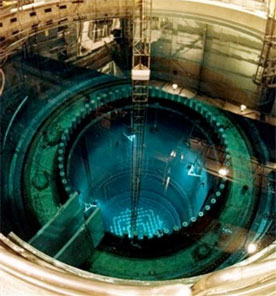
Image Credit: Daylife.org
Continuing in the recent thread of examining various power generation technologies, this week I’ll weigh in on nuclear power. I do this against my wife’s better judgment, and perhaps out of concern that my columns haven’t been generating enough controversy.
Let me start with the bottom line—that I am generally opposed to nuclear power, and I do not support the relicensing of Vermont Yankee beyond 2012. But some of my thoughts on both the benefits and concerns about nuclear power differ considerably from the standard no-nukes arguments.
What’s to like about nuclear power?
Given the specter of global climate change precipitated largely by fossil fuel combustion since the dawn of the Industrial Age, society must find alternatives to these old habits and the corresponding emissions of carbon dioxide. While nuclear power isn’t quite the carbon-free energy solution that most nuclear proponents suggest (due to carbon emissions associated with the uranium fuel cycle, plant construction, decommissioning, and so forth), the carbon intensity associated with nuclear power is far lower than that of coal, oil, or natural gas power generation. Many experts, including vice president Al Gore, argue that dealing with climate change is the “moral imperative” of our age, and quite a few environmentalists are suggesting—to even their own surprise—that nuclear power needs to be a part of the solution.
Solving the waste storage conundrum
Here’s where I’ll raise some eyebrows among my environmental friends. I believe that one of the most commonly raised concerns about nuclear power could be solved quite easily if we were a little smarter and were willing to consider a wholesale shift in our approach. The storage solution being developed today and for the last 30 years—sequestering high-level waste deep inside Nevada’s Yucca Mountain—would provide the highest level of safety at day one, then that level of safety would steadily decrease over time due to seismic activity, volcanism (the ridge is comprised mostly of volcanic tuff, emitted from a volcano), erosion, migrating aquifers, and other natural geologic actions. (Completing this facility has also met with so much resistance and delay that many doubt it will ever actually be opened.)
It seems to me that a far better solution for nuclear waste storage would be to put it in a place where the level of protection would increase over time. Why not bury it in a stable area of seafloor where sediment is being deposited at a fairly rapid rate. We know how to drill holes in the bottoms of oceans using undersea oil drilling technology—which could be adapted for this new purpose.
The nuclear waste could be stabilized (perhaps by “vitrifying” it into a glass form) and dropped into these holes, which would then be filled back in or capped. In some areas, more than a centimeter of sediment is being added to the seafloor every year. Over a few hundred years, a foot of compressed sediment would be deposited in these locations, and over several thousand years, that compacted sediment would be well on its way to becoming protective sedimentary rock. These small areas of ocean could be designated as off-limited to other uses to avoid accidents.
I’m far from an expert in nuclear waste, but I did take some geology courses back in my college days, and it just seems like common sense to put a dangerous material somewhere where the protection would get more—rather than less—robust over time.
Guessing that I wasn’t the first to suggest this storage option, I went to Google to see what’s been said about it. I found some fairly well-developed science on “sub-seabed storage” (the technical term for this approach)—and even support for the idea from a past president of the Union of Concerned Scientists.
Research into sub-seabed storage was supported by the U.S. Government from the mid-1970s through the mid-1980s, when the efforts were killed in favor of the Yucca Mountain “solution.” Politics, not science, seemed to spell its demise. There’s an excellent article on this from the Atlantic Monthly in October 1986.
Lest you think I’ve joined the ranks of Patrick Moore and other environmentalists who have shifted their position on nuclear power, I have not. I believe that some of the problems with nuclear power are solvable—such as long-term storage—but others are much tougher. Stay tuned; next week I’ll lay out these concerns.
Weekly Newsletter
Get building science and energy efficiency advice, plus special offers, in your inbox.















0 Comments
Log in or create an account to post a comment.
Sign up Log in